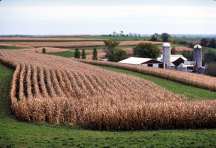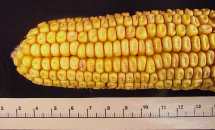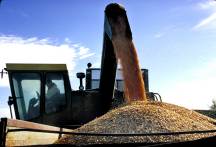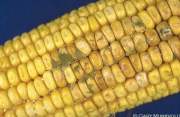Previous Page | Right click this page to print.
Corn
 In
the U.S., corn grain is the most important feed cereal grain. In the U.S.,
for 2001, the estimated total production of corn grain is 9,506 million
bushels. In the U.S., the predominant regions for corn grain production
are the Midwest and the Great Plains. Figure 4.2 illustrates a field of
corn. Corn is the most productive of the grain crops. The estimated average
yield is 138.2 bushels per acre. Corn has the ability to produce the greatest
amount of digestible energy per unit of land. In addition to high grain
yields, a field of corn produces both grain and stover. Stover consists
of the stalks, husks, and other nongrain portions of the plant. Stover
can also be processed and fed to ruminants as a fibrous feedstuff.
In
the U.S., corn grain is the most important feed cereal grain. In the U.S.,
for 2001, the estimated total production of corn grain is 9,506 million
bushels. In the U.S., the predominant regions for corn grain production
are the Midwest and the Great Plains. Figure 4.2 illustrates a field of
corn. Corn is the most productive of the grain crops. The estimated average
yield is 138.2 bushels per acre. Corn has the ability to produce the greatest
amount of digestible energy per unit of land. In addition to high grain
yields, a field of corn produces both grain and stover. Stover consists
of the stalks, husks, and other nongrain portions of the plant. Stover
can also be processed and fed to ruminants as a fibrous feedstuff.
Table 4.2 summarizes the average nutrient composition of corn.
Nutrient |
Average Composition,
% |
|---|---|
Crude protein |
10.4 |
Ether extract |
4.6 |
Crude fiber |
2.5 |
Ash |
1.4 |
NFE |
81.3 |
Starch |
72.2 |
Corn is an economical source of energy. Corn grain is high in starch. On average, starch is 72.2% of the total dry matter. Corn grain is also high in oil. On average, ether extract is 4.6% of the dry matter. Corn is also low in fiber. As a protein source, corn is low in protein quantity and quality. On average, the crude protein content of corn is 10.4%. In terms of amino acid profile, corn grain is deficient in lysine, methionine, and tryptophan; all of which are essential amino acids. The major protein in corn is zein. Zein is a poor quality protein; both in terms of a poor amino acid profile and low solubility. As stated, the lipid content in corn is relatively high. The lipids in corn increase energy content and palatability. In addition, the lipids provide essential fatty acids. In terms of minerals, corn grain is very deficient in calcium and moderately high in phosphorus. As with other cereal grains, phosphorus is bound and microbial phytase is required to make the phosphorus available. In terms of vitamin content, yellow corn is the only grain containing vitamin A precursors. Similar to other grains, corn grain is a fair source of vitamin E and a poor source of vitamin D and the B-complex vitamins.
Corn is divided into one of seven classes based on the corn kernel. The primary components of the kernel are the germ and the endosperm. The major commercial feed variety is dent corn. Dent corn is characterized by the dent in the top of the kernel. As the kernel loses moisture, the dent appears. Corn grain may be yellow or white. In the U.S., yellow is the preferred color because yellow corn grain contains carotenoids. Carotenoids are a group of molecules characterized by their yellow to red pigments. Beta-carotene is one of the carotenoids present in yellow corn. Beta-carotene is a precursor to vitamin A. Active vitamin A is only found in animal tissues. Vitamin A precursors are present in plant tissues. Yellow corn also contains xanthophylls. In contrast to beta-carotene, xanthophylls are not precursors to vitamin A. The primary function of xanthophylls is to provide color to such things as poultry skin and egg yolks.
Figure 4.3 illustrates yellow dent corn grain on the cob.

Figure 4.4 illustrates yellow dent corn grain.

Plants are classified as either C3 or C4 plants based on intermediates in their specific photosynthetic process. In C3 plants, the intermediate is a three carbon compound and in the C4 plants, the intermediate is a four carbon compound. Corn is a C4 plant. Each of the classes has specific characteristics. In comparison to the C3 plants, the C4 plants: 1) are more heat tolerant; 2) are more drought tolerant; 3) use nutrients more efficiently; and 4) produce relatively more carbohydrates. Corn is classified as a summer annual; planted in the late spring or early summer and harvested in the late summer or early fall.
Figure 4.5 illustrates a mechanical harvester harvesting corn grain. The mechanical harvester cuts the corn stalks, picks the ears of corn from the stalk, and removes the grain from the cob in the field.

Figure 4.6 illustrates a mechanical harvester transferring harvested corn grain to a truck.

Uniquely, corn grain has no significant intrinsic toxins. However, corn is susceptible to a number of antinutritional factors such as molds, smuts, and blights. One of the more common problems is fungi. The growth of fungi is characterized by the presence of mold. The fungi produce toxic substances called mycotoxins. In the animals, the mycotoxins cause a general decrease in health and productivity. Examples of mycotoxins associated with corn and other cereal grains include aflatoxin, zearalenone, vomitoxin, and fumonisin.
Figure 4.7 illustrates Aspergillus flavis. Aspergillus flavis will produce the mycotoxin aflatoxin.

For feeding livestock, corn grain is a digestible, palatable, and cost-effective energy source. In addition, corn grain rarely causes nutritional based problems. Corn grain is included in the diets of many of the livestock species. For swine and poultry production, corn-soybean meal based diets are the industry standard. The combination provides monogastric species with adequate sources of energy and protein. The diet will be supplemented with salt, minerals, and vitamins. Corn grain is commonly fed to beef cattle in feedlots. In finishing cattle, corn grain is associated with increased weight gain, increased feed efficiency, and improved meat quality. Corn grain is also a common feedstuff in the rations of lactating dairy cattle. Corn grain provides a means to increase the energy density of the ration to support high levels of milk production. Corn may also be fed to sheep. Both late-gestation ewes and fattening lambs are fed corn as an energy source. Generally, corn grain is not fed to horses, as the energy density is too great for most animals.
Previous Page | Right click this page to print.